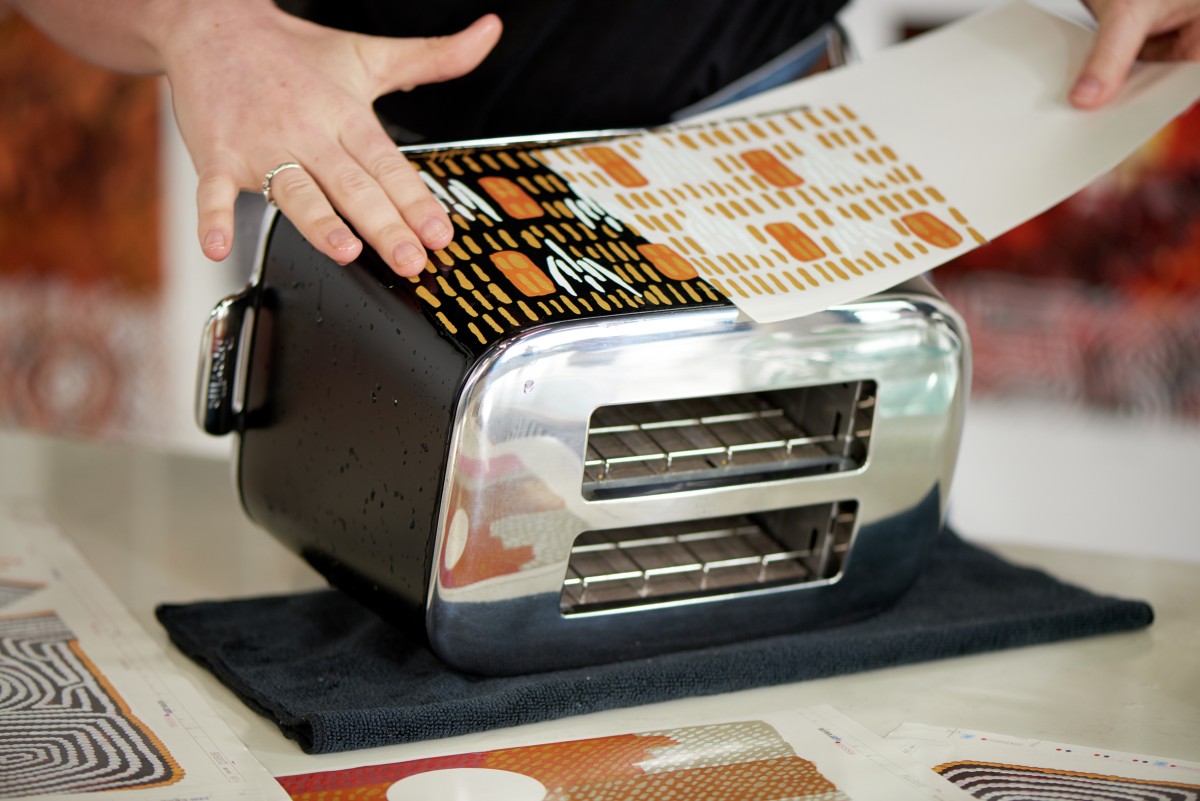A toast(er) to Aboriginal design
A unique collaboration between Breville and four Aboriginal artists shines in a new Culinary Collection and exhibition at the National Museum of Australia.

Warlimpirrnga Tjapaltjarri painting at his studio in Kiwirrkurra. Courtesy of Breville.
For some 2,000 generations, Australian Aboriginal people have been gathering around campfires to prepare and cook food. That history, and its continuing impact, are on view this summer as part of a unique exhibition at the National Museum of Australia in Canberra. Showcasing historic Aboriginal tools for living, An Aboriginal Culinary Journey: Designed for Living, spotlights a collection of Breville kitchen objects bearing designs by four contemporary Aboriginal artists.
“We have always made marks of meaning on our tools for living, so this idea is just keeping up with the times,” explained Margo Ngawa Neale, Head of the Centre for Indigenous Knowledge, Senior Indigenous Curator and Advisor, The National Museum of Australia.
It’s a passion project, instigated back in 2006 by Aboriginal designer and exhibition curator Alison Page and Richard Hoare, Breville’s Design and Innovation Director. They envisaged a collaboration between Breville appliance designers and Aboriginal artists as a way to share Indigenous culture, culinary traditions and stories to the world.
"When we step into a modern kitchen, it’s easy to forget that our wondrous appliances − while efficient, convenient, practical and aesthetic − provide the same service that our ancient ancestor’s campfires, grinding stones and stone age tools did over millennia,” says Page, aboriginal designer and curator of an Aboriginal Australian Culinary Journey.
It was on a trip to the remote Indigenous Kiwirrkurra community in Central Australia that Page and Hoare first met esteemed Western Desert artists and members of the original Pintupi Nine - Yalti Napangati, Yukultji Napangati, Warlimpirrnga Tjapaltjarri as well as Sydney-based artist and Yuwaalaraay woman Lucy Simpson. After experimenting with various approaches, the team ultimately decided to have the artists hand-paint directly onto the appliances. Not only did this ensure that the artist's work would be accurately reflected during production, but it also enabled the artists to respond to the form and shape of the objects.
To preserve each artwork's authenticity, look and feel, the production team 3-D scanned each finished appliance and developed an exact digital replica of the decorated product. Then, a multilayered decal was made and printed, which was meticulously applied by hand to each appliance.
It was important to Breville that each design embodies an aspect of Aboriginal culinary practice and storytelling. For example, the juicer designed by artist Yalti Napangati speaks to the age-old practice of Indigenous peoples grinding and juicing exotic plants in Australia. Titled Kampurarrpa Dreaming at Ngami, the design is based on the kampurarrpa (solanum centrale), or desert raisin, which has been a staple food of Indigenous peoples of Central Australia for thousands of years.
On Wednesday, June 15, Wanda Nanibush, AGO Curator of Indigenous Art, will join Margo Neale, Head of the National Museum of Australia’s Indigenous Knowledges Centre and Senior Indigenous Curator, and Terri Janke, Solicitor General & International Authority on Indigenous Cultural and Intellectual Property, for a live conversation about working with First Nation artists. For more information or to register for free, visit https://ago.ca/events/ago-x-breville-art-appliance.
One hundred percent of Breville’s profits from this Indigenous collaboration will go to the National Indigenous Culinary Institute, Indi Kindi by the Moriarty Foundation and the University of Technology Sydney. To see the full collection and more about the project, visit https://www.breville.com/ca/en/aboriginal-culinary-journey/home.html.
SHOP THE COLLECTION AT SHOPAGO
Breville is also committed to supporting Indigenous peoples and communities across Canada, and is proud to sponsor the Kananginak Pootoogook exhibition at the AGO.
Lead Sponsor
Lead Sponsor
Contemporary programming at the AGO is supported by
Contemporary programming at the AGO is supported by


